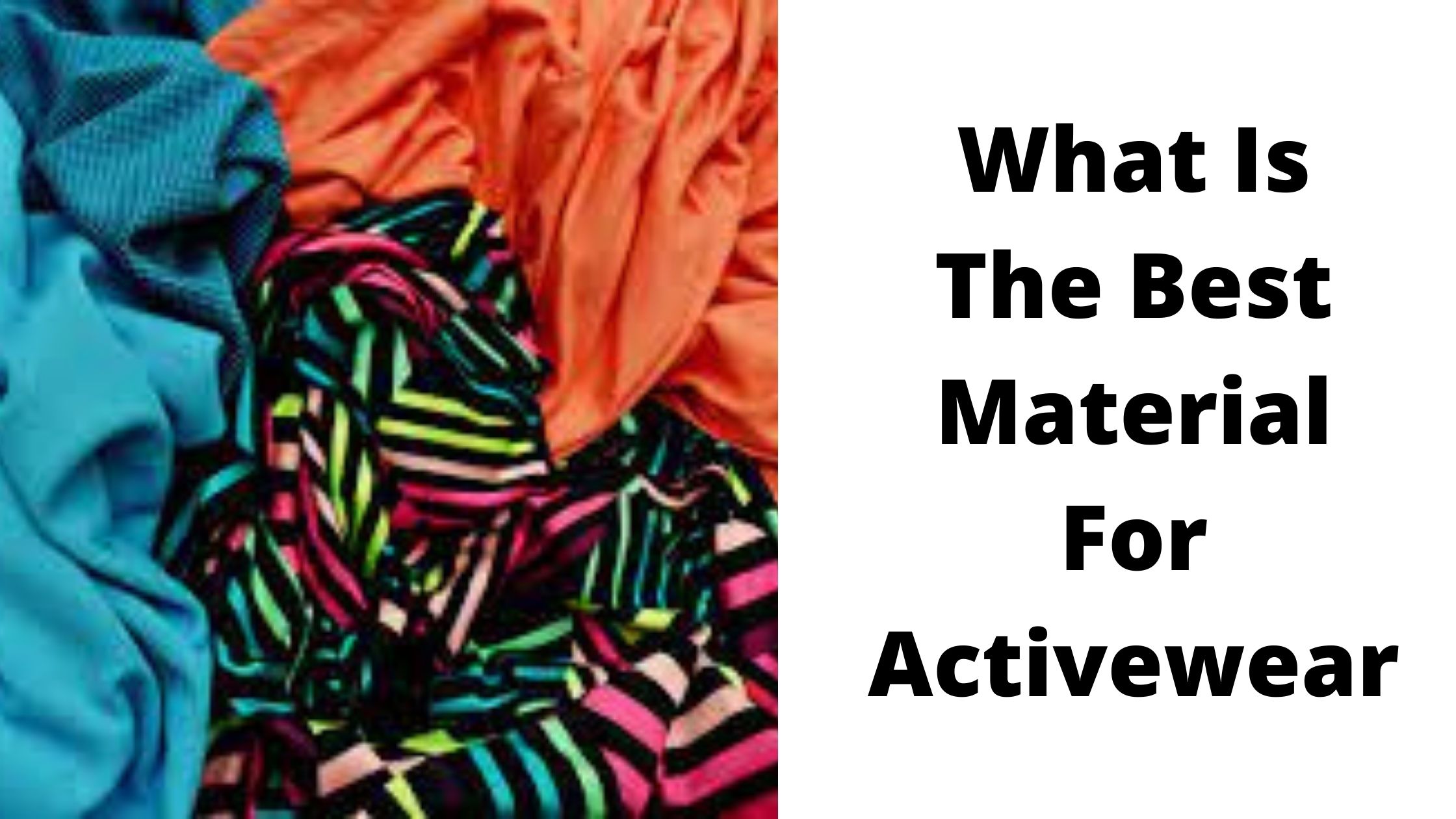You wore denim and went to the gym. You see everyone doing stretching exercises but your clothing didn’t help you, how would be if this happened? To achieve the maximum from your workout, you should choose the right material for you. So, what is the best material for activewear?
Choosing the right material will help you experience a better outcome with comfort. How would it be when you are going to the gym, you wear something that doesn’t suit this activity at all. To avoid this issue, you need to know about the perfect material for your workout wear.
What should you look for while choosing materials for activewear?
Before choosing the best material for activewear, have a look at the below factors!
- Strength & durability
Durability is the key to increasing the shelf-life of activewear. If high quality fibers that have great strength are blended to yield activewear then they better resist any wear, tear or the aging process.
- Breathability
The most important factor while choosing materials for activewear. You need to look for such material that is breathable and has moisture wicking properties. Air can easily pass out through breathable material and keep the body cool and fresh.
- Moisture
The material should pull out sweat molecules to the outer surface of the clothing to facilitate evaporation. It is an important criterion because while working out you will sweat like hell. So, if your workout clothes don’t have any moisture wicking properties, you will feel uncomfortable.
- Flexibility
The workout wear should offer a wide range of mobility without limiting your movements. If the workout clothing is made up of quality fibers, then they provide a great movement scope for you. You can move or bend while doing yoga as you wish. In the stretch out exercise, you can stretch your body like a feather.
- Protection
If you are doing any outdoor workout, then choose something that will protect you from the sun and provides UV protection or keeps you cool in warm weather and warm in winter.
What Is The Best Material For Activewear?
Materials that are extremely durable, breathable, have better moisture wicking properties, help in mobility and provide good protection are perfect for activewear.
Most importantly, flexibility is the key otherwise you won’t be able to do your workout properly. Choosing perfect gym leggings is a must in this case.
Nylon
No matter, if the weather is cold or hot or if you are doing squats or lifting dead weight, nylon is a perfect material to wear for heavy duty activity.
It is a perfect fiber for activewear due to its stretchability. It bends with your every movement. A perfect recovery is seen with nylon that enables your clothing to bring back to its original shape.
Nylon has great moisture wicking properties. This helps in wicking your sweat from the skin and evaporates it quickly into the atmosphere. This property of nylon has made it suitable for activewear.
Nylon is super soft that is used in almost everything like leggings, sportswear, t-shirt etc. The mildew resistance capacity of nylon is another plus point. Thanks to keeping clothing from getting affected by mildew. As nylon is hydrophobic (MR% of nylon is .04%), they resist mildew growth.
Spandex
Spandex comes from elastomeric polymer. It is the most stretchable fiber in the entire textile industry. More often, it is blended with other fibers like cotton, polyester, nylon etc. Spandex is marketed with the brand name Elastane or Lycra.
Spandex can stretch up to 5 to 7 times its original length. Where a wide range of mobility is needed, spandex is always a preferred option. Spandex has super elasticity property that helps a material to recover to its original shape.
When spandex is blended with any other fiber, the percentage of it regulates the stretch ability of that clothing. It wicks sweat in good content (Moisture regain% of spandex is 0.6%) and also dries quickly. But a sacrificing point is, it isn’t that breathable.
But it doesn’t limit the benefits of spandex. The high range of stretch ability makes it a perfect fit for fitness clothing. It shows an excellent ability to protest against friction. Again, good resistance against mildew is also seen.
While washing spandex material, always be careful. If you rigorously wash it in the machine and dry it with iron, then it can lose its stretching capacity. So, gently wash it and dry it in the open air.
Mostly spandex is used in skin tight clothing, sports bra, leggings, tracksuit, swimsuits, skin tight t-shirts etc.
Polyester
Polyester is the most popular fabric in fitness wear. It is extremely durable (Tenacity of polyester 5-7 g/denier), with no tension of wear, tear or pill. Even machine abrasion is easily handled by this fabric.
Polyester is hydrophobic (Moisture regain% is .4%). So, instead of absorbing water molecules, it wicks moisture from the skin and evaporates in the air. It shows a good elasticity (The elastic modulus of polyester is 90). So, high performance activity clothing with polyester, bends with your every move.
Polyester is wrinkle-resistant that can retain its shape better than any natural fiber. It is lightweight and breathable which makes it more suitable to serve as activewear. It has excellent resistance against friction and mildew.
But you need to wash your clothing right after your workout. Don’t let them sweat. It can cause a bad odor.
Polypropelyne
Polypropylene, a thin and flexible plastic has great strength. It is hydrophobic, so no tension of absorbing sweat even if it comes to the outermost layer of your clothing. Polypropylene can be used as base material or alone for any sportswear.
Stain resistance property enables you to relax for doing any task. If anything spills onto you unconsciously, just clean it out.
Bamboo
The most amazing part is it is softer than cellulose like cotton. Thanks to the micro gaps of bamboo. It has a good moisture absorption property. Though it absorbs sweat but fades away sweat in minutes. It keeps the body cool and feels so comfortable.
Anti-fungal and anti-microbial property is a plus point when it serves as activewear. No growth of bacteria or fungi is seen on this fiber.
These fibers can show excellent elasticity up to 20%. Sometimes, instead of spandex bamboo fiber is used. This biodegradable fiber is a perfect fit for outdoor activities. It has inherent UV protection in it that protects you from harmful UV rays.
Although bamboo is regenerated cellulose, it is very strong and durable like synthetic fibers which makes it super suitable for activewear.
Marino Wool
Wool is an amazing fabric that can regulate your body temperature. It can create a pocket to trap air in winter whereas extracts moisture or heat from your body in summer. Keeping you warm, it can be your perfect buddy for outdoor workouts.
Stain resistant property of wool also helps in secure wear. If anything spills on your clothing, it won’t stain. Just wipe it out.
The inherent anti-microbial property of wool helps wool clothing not to grow any bacteria from sweat. They even prevent the growth of microbes on the clothing.
Gore-tex
When you enter your gym, what workout you would prefer first? Running on a treadmill, right? Gore-tex is not a fabric for apparel. It works as a membrane and makes your apparel or running shoe water-proof. That means you won’t get wet by water or sweat. A continuous lamination layer enables not to soak in the water molecules. It does so while making the fabric extremely breathable.
Raincoats, jackets, and shoes are often made with this amazing material.
Tencel
Tancel has a porous structure that helps your skin to breathe. This recyclable fiber is sourced from wool. Some tini-tiny hair is seen on it that helps in expelling the sweat to the outer surface of the clothing to fade away in the atmosphere.
Tancel derives its name from tenacity that is often mixed with cellulose. As it has cellulose in it, it has the properties like natural fiber. Whereas its configuration is more like polyester which makes it inherently durable. So, it could be a good choice for fitness wear.
Econyl
Econyl is a sustainable nylon material that is recycled from nylon carpets, industrial plastic, nets etc. The most interesting part is these products can be recycled again. When anyone feels like dumping his cloth, it can be recycled to its original state and converted to another form.
X-Static
X-static fabric is a new invention in the textile industry to serve sportswear or activewear. Silver particle is used in clothing which makes it inherently anti-microbial. Even after heavy workouts, there is no chance to grow bacteria in your clothing. With a repeated wash, the performance of these silver particles won’t be less.
The Last Word!
I think you got your answer to the question “what is the best material for activewear?”If you choose your workout materials based on the above information, then you will probably need not worry about any issues regarding your workout.
Salma Hasin the author of this site completed her BSc. in Textile Engineering (Wet Processing Engineering). She wants to share her knowledge to help students in their studies and businessman & entrepreneurs in their businesses in making wise decisions fast.

